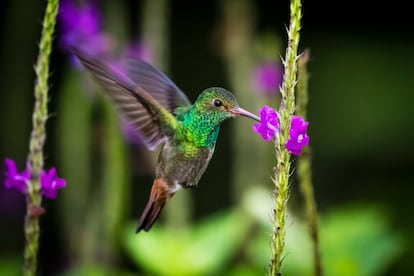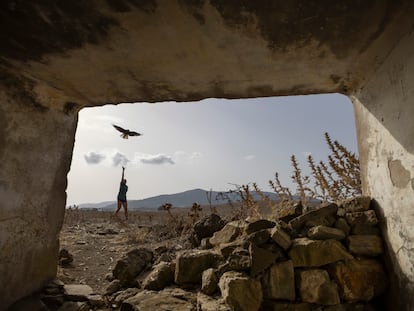This is the hummingbirds’ secret to finding food and shelter
A new study reveals the flight strategies that these speedy birds use to negotiate small, complex spaces

The flight of the hummingbird is as fascinating as it is mysterious. They have abilities that no other bird possesses: they can fly at high speeds in all directions — even backwards — and remain suspended in one place. But despite being great aeronauts, these tiny birds lack the ability to fold their wings at the wrists and elbows, and they cannot pause their flight, because the moment they stop flapping they start to fall. So how do they manage to slip through small spaces to take shelter, or to get food in hard to reach places? A group of researchers has detected the two strategies that these animals apply to sneak through the vegetation: either they turn their bodies to fly sideways through the gaps, or they tuck their wings against their body to shoot themselves like a bullet. These discoveries were recently published in the Journal of Experimental Biology.
Researcher Marc Badger from the University of California, Berkeley, noticed that the hummingbirds that visited his garden feeder had frequent territorial fights. The “intruders,” he explains, would sneak in and use the foliage as cover, while those being chased would fly through the bushes to take refuge. “I began to wonder about their interactions with vegetation, and how they negotiated such small, complex spaces,” Badger says. To clear up his doubts, he and his team installed a “flying arena” with holes that were smaller than a hummingbird with spread wings. He then designed a robotic arm that threw sand at the birds to force them to go through the hole, but the birds quickly got used to the device and forgot where the opening was. Then, his colleague Kathryn McClain came up with a reward system: the feeder would only provide nectar if they passed through the opening first. This way they were able to capture their flight strategies in slow-motion video.
After analyzing more than 500 crossings, they identified two strategies to pass through the gaps. In the first, the hummingbirds approached and floated to assess the opening. After analyzing and calculating the entry, they extended one wing forward and swept the second wing backward while continuing to flap to pass through the space sideways. “I was blown away the first time I saw a slow-motion video of the birds using this technique,” Badger confesses.
“Hummingbirds fly like helicopters. As soon as they stop flapping, they start falling from the sky,” explains Paolo Segre, a biologist at the University of Wisconsin-Green Bay who was not involved in the research. This is why the authors of the study were surprised to find out that the second method that hummingbirds use to pass through small spaces consists of throwing their wings back and briefly sticking them to their body to “shoot” themselves like a bullet. That is, they stop flapping. Once they cross safely, they resume flight. “This is risky, because they are basically falling,” adds Segre.
When the team examined the two strategies, they noticed that the hummingbirds that moved sideways tended to fly more cautiously and slowly than those that passed through the openings beak first. As the birds became more familiar with the setup, they became more trusting. During the experiment, only one suffered a major collision, but it quickly recovered before successfully attempting the maneuvers again and continuing on its way. The four hummingbirds that participated in the study exhibited a similar transition between flight systems. According to Badger, this indicates that when they find similar obstacles in their natural environment, they adjust their behavior as they learn more about their habitat. For example, if they face a predator, such as a cat, while they are in free flight, they will probably opt for a more cautious strategy in order to protect themselves.
In the wild, many species of hummingbirds forage for insects near and within vegetation. Females collect cobwebs and other nesting materials and build their nests inside trees and bushes. Overall, these abilities show that hummingbirds can reliably negotiate tighter spots than is typically observed.
Is there a reason to continue learning from nature? “Yes,” Badger reflects. “Learning more about how animals avoid obstacles and other basic elements of the environment can improve our overall understanding of animal behavior in complex environments.” Segre, for his part, notes that “we are just beginning to learn about the most complex aspects of hummingbird flight.”
Other interesting facts about hummingbirds
- It is the smallest bird on the planet, and its only habitat is the American continent. The 343 known species are distributed from Alaska to Patagonia.
- Considering their size, they have a very high heart rate. In a minute at rest, their heart can beat from 500 to 700 times. In active state they reach 1,200. This occurs because they expend a significant amount of energy for flight.
- Thanks to their tetrachromatic vision, they can see more colors than humans.
- Their legs are not useful for walking. They use them for two main activities: holding on to tree branches to rest or sleep, and scratching.
- They have a mating ritual known as dive-bombing. To impress the females, the males rise up to 65 feet high and then suddenly drop. Then, before reaching the ground, they stop abruptly and rise again. The females look for the most graceful male, or the one who reaches the highest point.
Sign up for our weekly newsletter to get more English-language news coverage from EL PAÍS USA Edition
Tu suscripción se está usando en otro dispositivo
¿Quieres añadir otro usuario a tu suscripción?
Si continúas leyendo en este dispositivo, no se podrá leer en el otro.
FlechaTu suscripción se está usando en otro dispositivo y solo puedes acceder a EL PAÍS desde un dispositivo a la vez.
Si quieres compartir tu cuenta, cambia tu suscripción a la modalidad Premium, así podrás añadir otro usuario. Cada uno accederá con su propia cuenta de email, lo que os permitirá personalizar vuestra experiencia en EL PAÍS.
¿Tienes una suscripción de empresa? Accede aquí para contratar más cuentas.
En el caso de no saber quién está usando tu cuenta, te recomendamos cambiar tu contraseña aquí.
Si decides continuar compartiendo tu cuenta, este mensaje se mostrará en tu dispositivo y en el de la otra persona que está usando tu cuenta de forma indefinida, afectando a tu experiencia de lectura. Puedes consultar aquí los términos y condiciones de la suscripción digital.
More information
Archived In
Últimas noticias
Most viewed
- Reinhard Genzel, Nobel laureate in physics: ‘One-minute videos will never give you the truth’
- Oona Chaplin: ‘I told James Cameron that I was living in a treehouse and starting a permaculture project with a friend’
- Pablo Escobar’s hippos: A serious environmental problem, 40 years on
- Why we lost the habit of sleeping in two segments and how that changed our sense of time
- Charles Dubouloz, mountaineering star, retires at 36 with a farewell tour inspired by Walter Bonatti













































